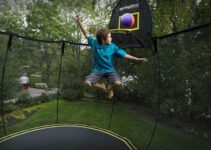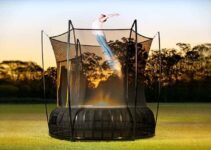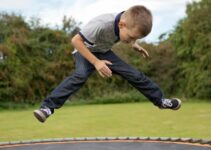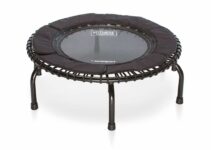One basic compound of a trampoline is Polypropylene material. Most of the outdoor recreational trampolines are made of highly sustainable steel which ensures a lot of jumping force.
In terms of components of trampolines, the most common are frame, mat, springs, net, and safety padding. Each of them together withstands constant flexing and makes a trampoline safe & an enjoyable ride.
In this article, I will break down every part separately and dig deep into every definition including the material it is made of and an overall guideline.
What are Trampolines made of
The safety pads or trampoline mat is made of polypropylene material, which is resistant to UV light and durable. Springs are usually made of galvanized steel, but springless trampolines use flexible composite rods made of fiberglass that is making Trampoline bounce better & safer. The trampoline bed swing is made of woven fabric that makes the trampoline springs safe and sound.
The net is made of UV-resistant polyethylene or polyester and is designed to prevent injuries and absorb impact. Safety padding is made of thick, shock-absorbent foam covered with PVC or vinyl.
Lets explore into the detail so you can get to know which material is used for what component of a Trampoline.
Trampoline Spring Material
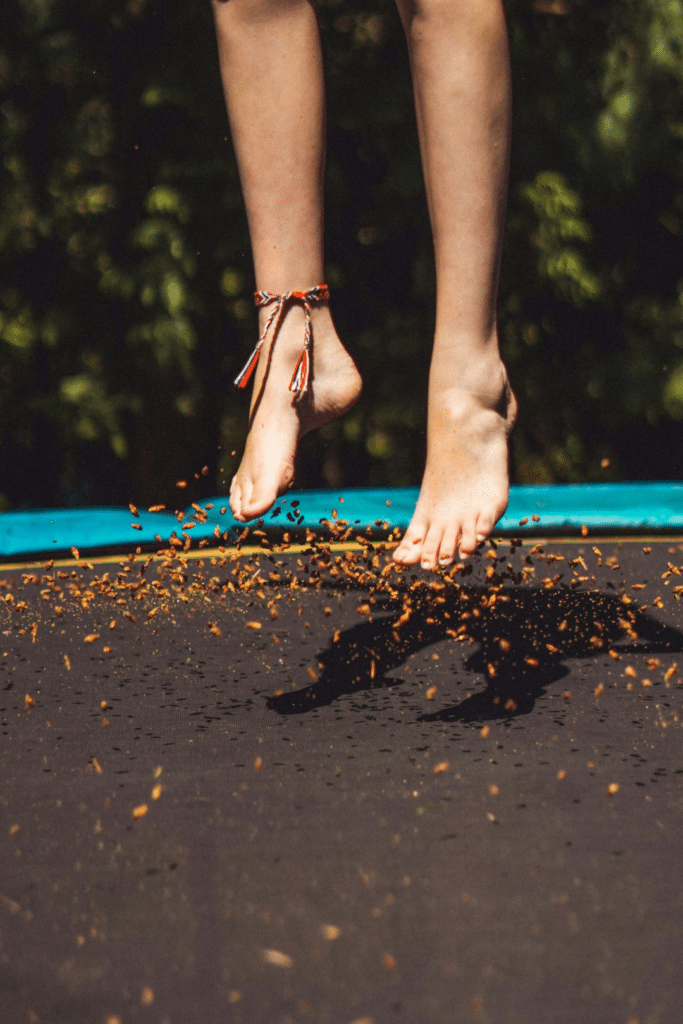
Trampoline spring either made of steel or composite rods.
Steel is for Spring oriented Trampolines on the other hand, composite rods or elastic bands are a material for Springfree Trampolines
Most recreational outdoor Trampoline’s spring typically made of coiled spring for extended durability.
Those Steel of springs are made of different materials, such as steel, galvanized steel, and zinc-plated steel, are used to enhance performance and durability of trampoline springs. The variation of spring’s steel made of coating with zinc or galvanize.
Traditional Spring Trampoline:
Here are the Spring type of regular or traditional Trampoline:
Tensioned springs
These springs are typically made of durable, resilient materials such as steel and are strategically positioned around the perimeter of the frame. Their primary function is to absorb the impact energy generated by the jumper and then release it, propelling the jumper into the air.
Tapered or Conical Springs:
Tapered or conical springs are designed to have a narrower diameter at one end and a wider diameter at the other. This shape distributes the stress more evenly along the length of the spring, resulting in a smoother and more controlled bounce.
Leaf Springs:
Leaf springs consist of multiple layers of metal strips stacked on top of each other and bolted or clamped to the trampoline frame.
Spring-Free Trampoline:
Here are the types of Spring for the Spring-Free Trampoline
Elastic bands
They have emerged as an alternative to traditional tensioned springs in some trampoline models. These bands are typically made of high-strength elastic materials and are attached securely between the frame and the jumping surface.
Composite spring:
Such Spring is made of composite rods which are used as an alternative to traditional metal springs, particularly in spring-free trampoline designs. Instead of relying on coiled metal springs for bounce, these trampolines utilize flexible composite rods made of materials such as fiberglass or carbon fiber.
Safety Net
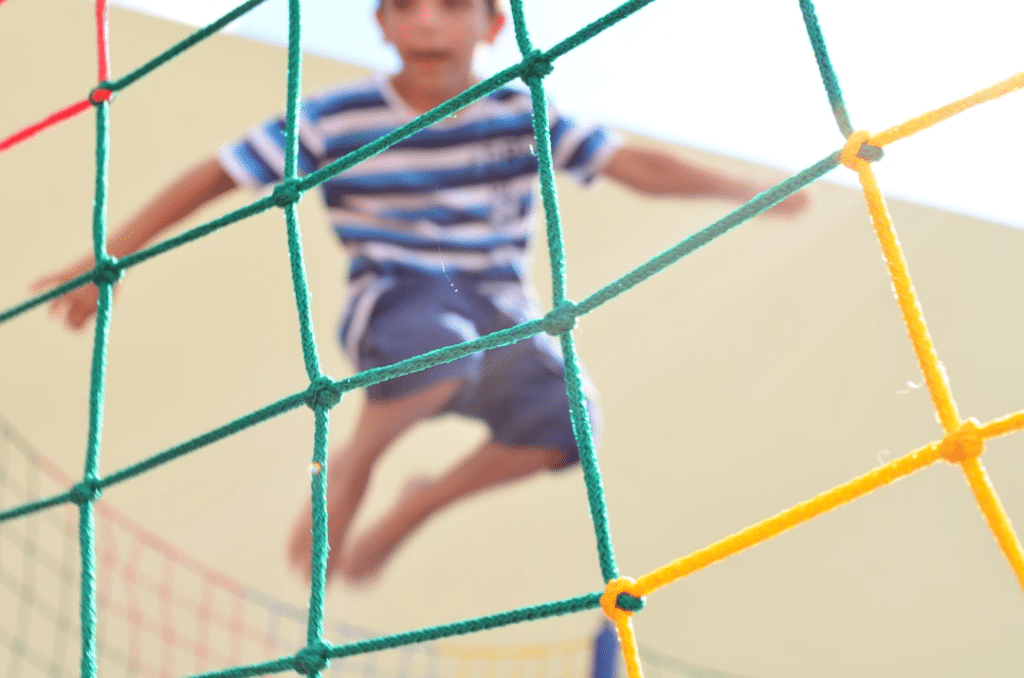
The safety net is made of UV-resistant polyester material
The safety net is a protective barrier to prevent users, especially children, from falling off and potentially injuring themselves.
This net should ideally be positioned outside the springs to maximize safety. Additionally, inquiring about the net’s material composition and UV resistance is essential for durability against weather elements.
In traditional spring trampolines, the safety net typically attaches to the outer perimeter of the frame and is positioned outside the springs. This placement ensures that jumpers are contained within the jumping surface and reduces the risk of contact with the springs, minimizing the potential for injury.
On the other hand, spring-free trampolines often feature safety nets that are integrated into the design to complement the absence of traditional metal springs. These nets are strategically positioned to provide a secure enclosure while maintaining the trampoline’s bounce characteristics.
Additionally, the shape of the safety net may vary depending on the shape of the trampoline. Square trampoline nets are designed to fit the specific dimensions of square trampolines, providing optimal coverage and protection for users. Similarly, rectangle trampoline nets are tailored to the unique shape of rectangle trampolines, ensuring a snug and secure fit around the entire jumping area.
Trampoline Frames
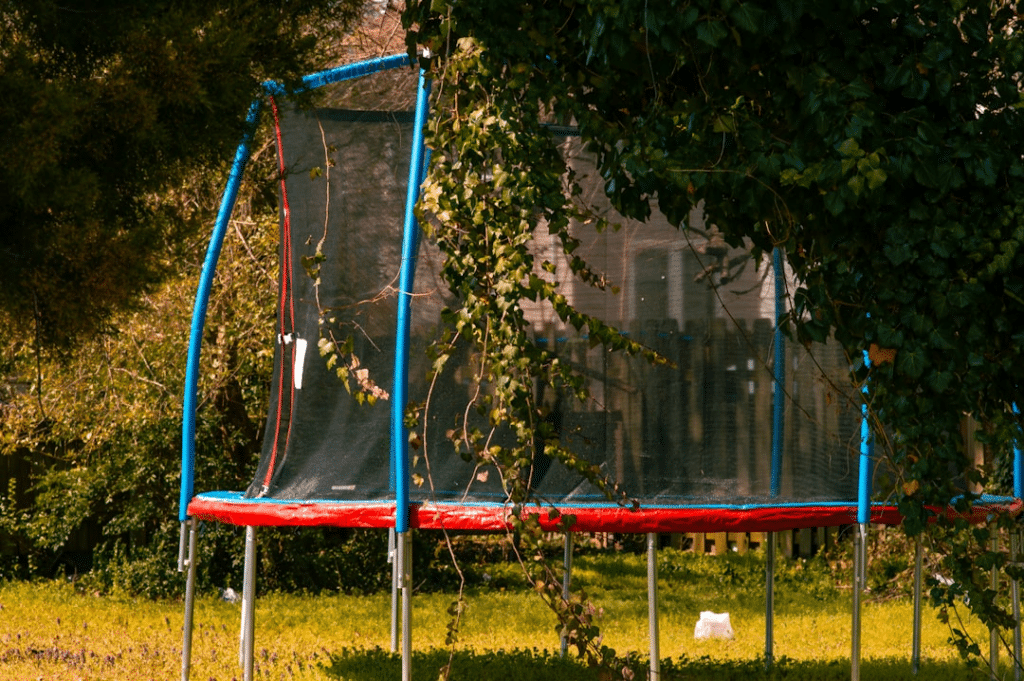
Trampoline Frames are made of Steel or Aluminum, Tubing, Corrosion coating, joints, or connection.
- Steel or Aluminum:
Steel frames, particularly those made of galvanized steel, are a popular and durable choice. Aluminum frames are lighter but may be more suitable for smaller trampolines or recreational trampolines.
Steel springs, including zinc-plated and galvanized springs, are commonly considered the best choice for trampolines due to their strength, durability, and rust resistance.
- Rust-resistant coatings:
Trampolines with a galvanized finish have undergone a process where the frame is coated with a layer of zinc, providing excellent corrosion resistance.
Galvanized steel is often used for outdoor trampolines due to its rust resistance.
It helps prevent scratches, chips, and fading, ensuring that the trampoline maintains its appearance and structural strength for years to come.
Similarly, trampolines featuring a black powder-coated finish on the frame offer enhanced protection against rust and corrosion. The powder-coating process involves applying a dry powder to the frame’s surface, which is then cured under heat to form a tough, protective layer.
Moreover, this black powder-coated finish not only provides aesthetic appeal but also adds an extra level of sturdiness to the frame
- Frame Joints:
The joints and connections of the frame are crucial for stability, and the attachment to the jumping mat (using tensioned springs or elastic bands) affects the trampoline’s bounce characteristics.
Welded joints are common, providing great bonding where metal components intersect. These joints offer robust support, enhancing the overall strength of the frame.
Bolted connections are also prevalent, employing bolts, nuts, and washers to secure frame pieces together. They facilitate easy assembly and disassembly, allowing for adjustments as needed.
Clamp joints feature brackets or clamps to connect frame sections, often requiring screws or bolts for stability. They are frequently utilized in joining tubing sections or attaching accessories like safety enclosures
Jumping Mats:
Trampoline mats are made of polypropylene material, also known as PP, and polyethylene, also known as PE.
The best material for trampoline mats is typically woven polypropylene fabric, which offers strength, sustainability, UV resistance, and flexibility.
Apart from that some mats come with vinyl covers that are made of woven fabric.
The Jumping mat fabric is made of either Nynlon or Canvas.
Both materials are durable and have a high resistance to UV rays, making a trampoline mat suitable for outdoor use. Other materials, such as nylon and canvas, are occasionally used but are less common.
Here are some main features of competitive trampoline mats
- The material is naturally resistant to UV light and water exposure from the sun.
- The fabric is resilient, and can withstand the constant stretching and pulling that comes with bouncing for backyard trampolines.
Mats can also undergo different UV treatments.
If exposed to direct sunlight frequently, polypropylene loses its embedded resistance to UV light.
Depending on the weave density, UV resistance, and added treatment, the mat’s lifespan can be determined.
Safety pads
Padding also referred to as safety pads, is placed around the perimeter of the trampoline frame and over the springs. Its primary purpose is to provide cushioning and protection to the jumper. Safety pads are usually made of thick foam covered with a durable, weather-resistant material. They help prevent jumpers from coming into direct contact with the springs and frame, reducing the risk of injury from accidental falls or collisions.
ANCHORS
Anchors secure the trampoline firmly to the ground, preventing it from shifting or overturning during use, especially in windy conditions. Properly anchored trampolines enhance stability and reduce the risk of accidents related to trampoline movement.
Here are three common types:
Auger Anchors: These corkscrew-like devices dig deep into the soil, providing robust stability. Made of durable steel, they offer easy installation and removal.
Stake Anchors: Similar to auger anchors, these long metal stakes are driven into the ground at an angle. They excel on softer surfaces like grass or soil, firmly securing the trampoline in place.
Strap Anchors: Utilizing heavy-duty straps attached to the trampoline frame, this method anchors to fixed objects like trees or concrete blocks. Ideal for hard surfaces where traditional ground anchors aren’t feasible.
Enclosure Pole
Enclosure poles are typically made of steel or aluminum for strength and sustainability. Steel poles offer robust support and stability, while aluminum poles are lighter and more resistant to rust and corrosion.
Tubing
Tubing is used for the frame and legs, with varying sizes depending on the model. It is an important part of a Frame that is also typically made of galvanized steel or aluminum, tubing is cut and shaped to fit the trampoline’s design specifications. It is assembled using welding, bolting, or clamping techniques, integrating with other frame components such as the jumping mat and safety enclosure
How to choose the right quality of Trampoline?
Choosing a high-quality trampoline is not just about elevating your bouncing experience; it’s about safeguarding against potential hazards and ensuring years of enjoyment.
1. Enduring Frame: Providing Stability and Strength
The frame is the foundation of any trampoline, dictating its strength and longevity. Opt for frames crafted from high-quality, EU-certified materials, such as galvanized steel coated with zinc. This combination provides exceptional resistance to corrosion, ensuring your trampoline stands strong against the elements for years to come.
2. Effortless Assembly: Simplifying Set-Up for Immediate Enjoyment
A well-designed trampoline should offer easy assembly without compromising structural integrity. Look for models that require minimal screws and parts, streamlining the setup process. Simple assembly not only saves time but also reduces the risk of installation errors that could compromise safety.
3. Long-lasting Springs: Ensuring Reliable Bounce Performance
Rust-resistant springs are the lifeline of a trampoline, maintaining elasticity and preventing breakage over time. Choose trampolines equipped with durable springs made from corrosion-resistant materials. These springs ensure consistent bounce performance and minimize the need for frequent replacements.
4. Resilient Jumping Mat: Withstanding Wear and Tear for Endless Fun
The jumping mat is where the magic unfolds, bearing the brunt of every leap and bound. Opt for mats crafted from non-toxic, weather-resistant materials that can withstand prolonged exposure to sun, rain, and fluctuating temperatures.
For UV-ray protection, Trampoline mats commonly come with UV radiation-resistant Nylon
Additionally, ensure proper ventilation to prevent moisture buildup and prolong the mat’s lifespan.
What is the bouncy part of a trampoline made of
The bouncy part of a trampoline, known as the jumping mat, is typically made of polypropylene or polyethylene material. These types are the best quality trampoline. Their materials are chosen for their sustainability and resistance to UV light, ensuring they can withstand the rigors of outdoor use. Additionally, some jumping mats of Bounce Pro Trampoline are made of nylon or canvas, although these materials are less common.
Polypropylene and polyethylene offer excellent elasticity, allowing the jumping mat to stretch and rebound with each bounce. They are also resilient against constant stretching and pulling, maintaining their shape and performance over time.
What are the benefits of trampoline frames?
Trampoline springs offer an exhilarating bouncing sensation, act as shock absorbers to reduce impact on joints and muscles, and provide exceptional longevity and durability. They enhance the overall trampolining experience and make trampolining a lower-impact exercise compared to other activities.
So, this is up the overview of frame benefits of it.
Any specific advantage of a Trampoline frame depends on the type of Trampoline Frames. Based on it’s type here are the differences:
- Steel trampoline frames are known for their strength and resistance to bending, making them suitable for heavy-duty outdoor use.
- Aluminum trampoline frames are lightweight, rust-resistant, and easy to move, making them a convenient option for users.
- Galvanized steel frames are highly resistant to rust and corrosion, offering durability and low maintenance.
- Other metal options for trampoline frames include stainless steel, weather-resistant alloys, composite metal frames, and powder-coated steel frames, each with their own benefits.


